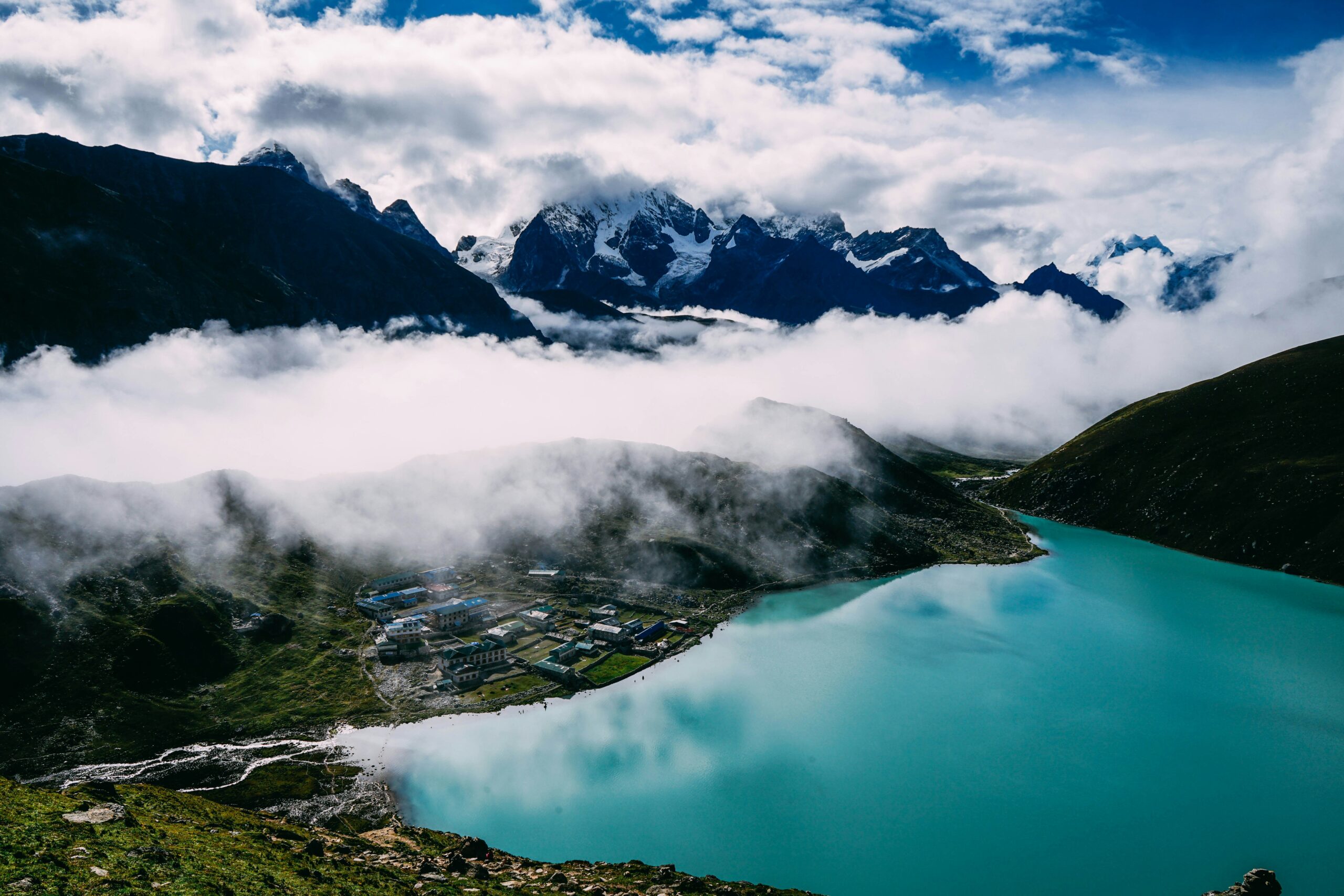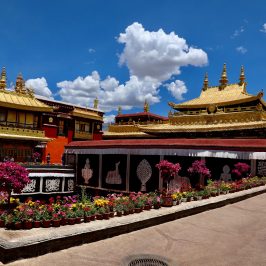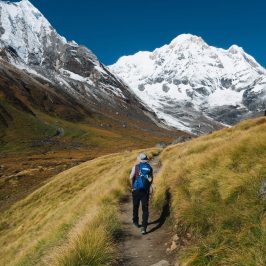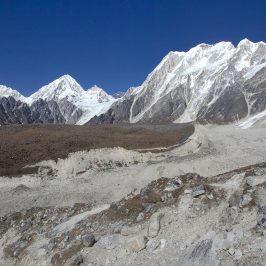Everest Base Camp Trek via Gokyo Lake and Cho La Pass is a challenging trek in the Everest/Khumbu region that includes the Everest base camp, the Gokyo valley, and the high Chola pass (5420m), many Himalayan giants, including Mt. Everest (8848m), Lhotse, Makalu, Amadablam, Kanchenjunga, Nuptse, Mt. Pumori, and others, maybe seen from this trekking route. Natural beauty, the Sherpa people’s rich and distinct culture, lush forest, walking through the snow, and crossing a high pass all present tourists with beautiful delights that will last a lifetime.
Conquering Heights:
Gokyo Valley is a secluded Himalayan valley with landscapes of mountains, glaciers, and Gokyo Lake, during the trek, you may get the opportunity to witness the Dumje festival, which takes place in April, and the Mani Rimdu Dance, which is performed in Sherpa monasteries. Mountain panoramas, Gokyo Valley’s Sacred Lakes, picturesque River valleys, glaciers, and crossing Chola Pass are among the trek’s highlights.
Everest Base Camp Trek via Gokyo Lake and Cho La Pass adventure begins with a picturesque flight from Kathmandu to Lukla, This journey begins in Lukla and follows the Dudh Koshi River valley, you’ll pass through lush rhododendron and pine forest, the Dudh Koshi valley, the Sagarmatha national park, high passes, waterfalls, and magnificent Sherpa settlements such as Phakding, Namche Bazaar, Tengboche, Lobuche, and Pheriche, among others.
The UNESCO-listed Sagarmatha National Park is home to a diverse range of flora and fauna, as well as species such as the snow leopard, red panda, and Himalayan Thar. The Sherpa people’s pleasant nature and warm greetings enhance the visitors’ experience. Gokyo Lake & Cho La Pass journey also includes a visit to Kala Pattar, which provides a spectacular view of Mt. Everest, as well as Ama Dablam (6856m), Kantega (6809m), Kwangde (6194m), Mt. Nuptse (7879m), and Mt. Lhotse (8511m.). From mid-March to May, and from September to Mid-December are the ideal seasons to trek to Everest base camp.
Best Time to Travel & Weather Condition:
The ideal seasons for Everest Base Camp Helicopter Trek are spring (March to May) and fall (mid-September to November). During these seasons, the weather is dry and clear, making it perfect for trekking and basking in pristine mountain landscapes. The days are pleasant, while the evenings are cool. However, because these are peak seasons, the trails get crowded and busy.
The foothills are enchanting with wildflowers, especially rhododendron blossoms, in the spring. The Base Camp is transformed into a tented city during the climbing season, with climbers and Sherpa guides. Trekking to Everest Base Camp is extremely popular in the autumn, you may experience extremely clear sights during this season due to the ending of the heavy monsoon season, which clears the atmosphere.
If you plan your journey around October, you’ll be able to attend Mani Rimdu, the Everest region’s most significant festival, people from Tengboche, Chiwong, and Thame monasteries all participate in this celebration.
Entry Permits & Requirements:
The Everest Base Camp Helicopter Trek requires two permits:
1) Sagarmatha National Park Entry Permit and
2) Khumbu Rural Municipality Entrance Permit.
Unlike many Nepal Himalaya climbs, you won’t require a TIMS (Tourist Information Management System) card for this one.
The Nepal Tourism Board’s office in Kathmandu or the park’s entrance gate in Monjo can provide you with Sagarmatha National Park Entry Permit for NRS 3000.
The fee for citizens of SAARC nations is NRS 1500.
You must complete the permit application and present your passport or a copy of your passport. You must be in Lukla to obtain the Khumbu Pasang Lhamu Rural Municipality Entrance Permit. The permission costs NRS 2000 and may be acquired at the rural municipality counter on the outskirts of the settlement. You won’t have to worry about waiting for permits since the company or our guides will take care of everything.
Travel Insurance:
All clients participating in any activity must have travel insurance. Personal injury, death, hospital expenditures, repatriation fees, helicopter rescue, and any other disease covered by the insurance plan will be given, we highly advise you to acquire a comprehensive insurance plan from a trustworthy insurance company.
Passport and Visa:
Every client must have a valid passport from the return date with a 6 months prior validity by the Nepalese consulate in your country or immigration office at Tribhuvan International Airport in Kathmandu.
Equipment lists
- Find the guidelines regarding essential trekking gears.
- Daypack above 40 liters. (Must be waterproof)
- Down jacket (rental available)
- Warm sleeping bag (rental available)
- Sun head, gulf cap, sunglasses, headlamp, and torchlight.
- Ear-muffs, sun Lotions/sun cream.
- One pair of liner gloves is thin wool and synthetic.
- Cotton t-shirts, Synthetic t-shirt.
- Two Long sleeve polyester or synthetic lightweight for sunny days.
- One Soft-shell jacket water & wind resist.
- One swimming dress.
- Inner clothes as your requirement.
- Liner socks, woolen socks.
- Proper trekking shoes.
- Imodium or Pepto Bismo capsules for upset stomach or diarrhea.
- Diamox for altitude sickness. The guide will help you to take it.
- One small personal-sized first-aid kit with blister treatments such as moleskin, bands, anti-infection ointments, muscle relief ointments.
Meals and Drinking Water:
In popular trekking areas like Annapurna, Everest, Langtang, and Manaslu, the menu system offers a variety of ethnic cuisines and western meals, while certain places serve authentic Nepali meals, distinct from international cuisine. Local cooks, trained for cleanliness and hygiene, prepare these meals at each tourist lodge and tea house. Additionally, lodges provide safe drinking water or bottled mineral water. If you buy a water purification tablet from Kathmandu you can take water from the tap and purify it by yourself, this will be cheaper and control plastic pollution as well.




